After the mid-January super-freeze, as temperatures broke the freezing mark, a few birds began to show in my home range, although they were extremely widely spaced. That’s pretty typical of mid-winter in North Dakota, but recent forays into the open prairie revealed a Rough-legged Hawk here, a Northern Shike there, and a Sharp-tailed Grouse flying by. But during the last Friday afternoon of January I needed to attend to a bad case of cabin fever, multiplied by a sunny sky.
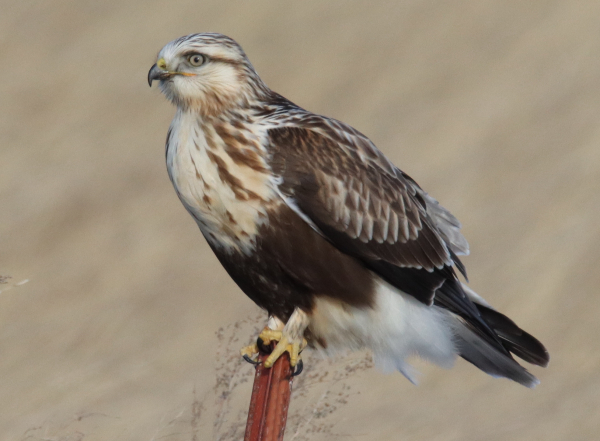
Due to drive south, I continued as far as the road would take me, which is about 5 miles north of the border between the Dakotas, and that’s where I turned east. Along the way I drove through some of the richest plains bird habitats, but it seemed as if the land and sky were turned off – sorry, we’re closed. As I reached the high escarpment at the eastern edge of the Missouri Coteau, where the steep hills drop down into the low flat Drift Plain, the marked change and the expansive view always makes me take a deep breath and clear my mind, but as I let that breath out I saw a hovering hawk, which indicated there was a 95 percent chance it was a Rough-legged Hawk during this time of year in this location.
A closer look showed it was a black-brown colored dark morph Rough-leg – nice. Dark morph birds are rarer and always provide a higher level of excitement for me. By that time the hawk was perched in a lone tree, and I positioned my car so I was within photo range with the sun at my back, and waited for the black beauty to fly, hoping it would give me a chance to take a flight photo, or a series of photos as it potentially banked into the wind or dived toward prey in my direction at an unseen rodent beneath the dried grasses. The hawk kept me waiting, then bailed without providing a photo op – darn, but it was worth the try, after all, birds were few and far between.
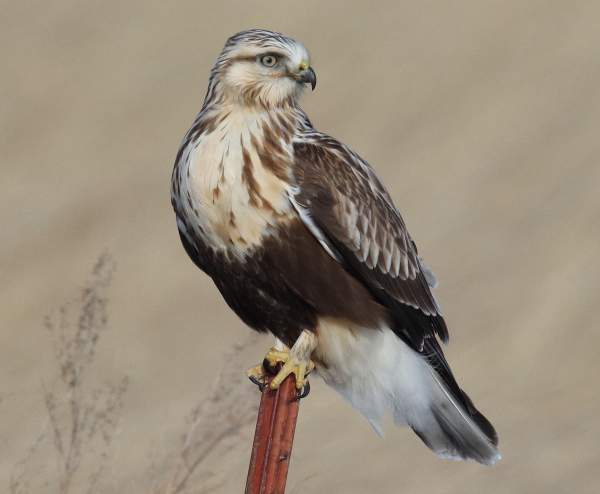
Little did I know though, the black hawk was the first of 9 Rough-legs I would see along the next 10 miles, along with 2 Short-eared Owls – what a great breakthrough! But it was the second hawk that provided the only photo opportunities. Just a half-mile beyond the first hawk, I was surprised to see the second Rough-leg, this one perched on a low fence post on the edge of a field covered with tall grass. I slowed to approach the hawk, instantly knowing I was in perfect position to take advantage of prime afternoon light, but as with any bird, the question was “Would it permit me to stop within photo range without alarming it?”
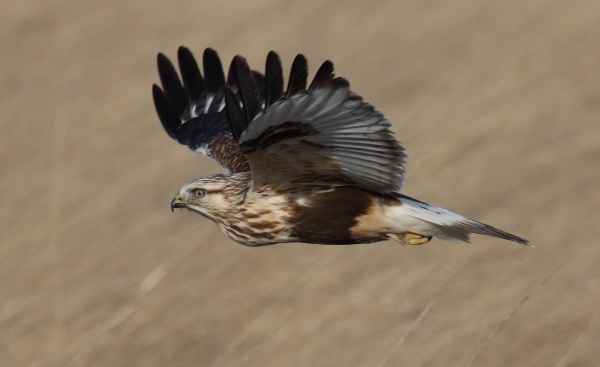
As it turned out, this was one of the most trusting Rough-legged Hawks I’ve ever encountered, so to start I simply took a few portrait photos as it was perched, but on the hunt, looking this way and that. This was a very pretty bird, clearly a young hawk as evidenced by the white-tipped border along the end of the wing flight feathers and tail feathers. I took the first images using my usual preset f-8 aperture, but toned it down to f-6 with the interest in blurring more of the background vegetation.
In time I noticed the hawk look directly below its perch, then suddenly, the young hawk spread its wings and dropped straight down, pushing its feet quickly downward in a pouncing motion as it reached the ground. It stood with its wings raised in the dry grass, which was about 5 inches high on that side of the fence post (at least 3 feet high behind it). After a moment the hawk folded its wings and tipped its head downward, raising up again with a vole in its hooked beak, then bending over again and actively feeding for a few minutes, mostly behind the cover of grasses. All that time I was ready for the hawk to wing it, and after raising its head, looking this way and that, it took off.
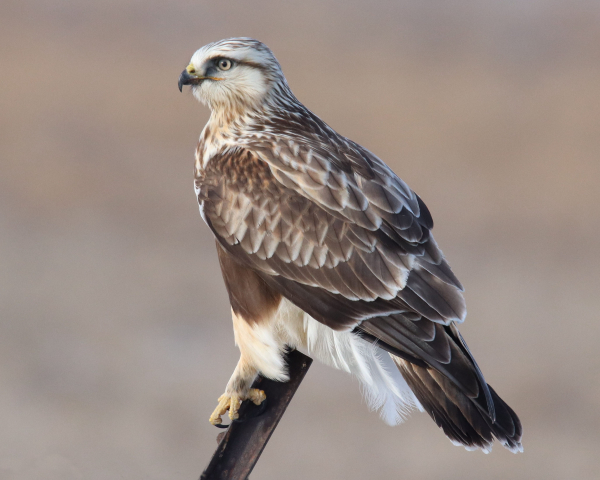
I had already switched the camera’s aperture setting back to f-8 to increase the area in focus to be broad enough so the full wingspread, while preserving as much shutter speed as possible with the hope of keeping the take-off and flight photos sharp. It worked, and after taking a few photos as the Rough-leg passed by my position, I lost sight of the hawk but felt good about the photos I took in its company. I circled around and saw the young hawk was perched just a short distance away on another metal fencepost.
Now the young hawk was positioned on the “wrong side” of the gravel road that would give me access to approach. Even so, I persisted and tried to position where I would get a somewhat glancing illumination of the hawk. Not expecting very good results as I was photographing from the backside of the bird, I could see the sunlight reached the hawk’s back and tail plumage, so I tried a couple photos when the bird turned its head into the light.
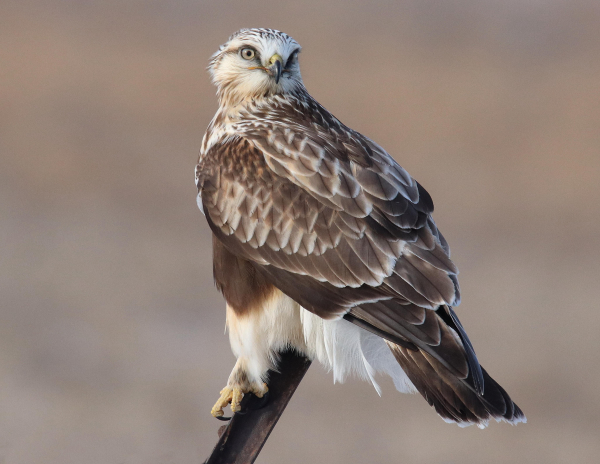
Interested, I checked the camera’s LCD monitor to see what the lighting looked like and if the bird was free of shadowed areas. Most photos looked pretty good, but they definitely had a different tone of color, and a different landscape color behind the hawk. Even so, when viewed on my computer screen at home, the photos were an interesting compliment to the initial photos I took when I was photographing the young hawk illuminated in perfect afternoon sunlight.
That’s exactly what I want to share with you in the photos that illustrate this article: The differences between photo results of the hawk images taken in an optimum lighting position during a sunny winter afternoon and an alternate lighting position with a slightly less than realistic coloring of the same bird from a backside angle. Comparing the images taken from different positions with respect to the hawk and direction of the sunlight, I don’t think anyone would bet that this was the same bird.
I’m not sure what I can offer beyond that with regard to the 2 photo results, but I usually wouldn’t have attempted the second photo session, having had a perfect photo opportunity before the hawk left its initial perch. However, there is something very special about the second group of photos too, and by showing the best images and providing insights into the lighting circumstances, I think it’s valuable to show the dual results. Then too, even though I saw 9 hawks and 2 owls that afternoon, the young hawk provided my only photo opportunities, which emphasizes how important it is to take advantage of trusting birds while making the most of prime sunlight periods when we venture afield. Good Luck!
Article and photographs by Paul Konrad
Share your bird photos and birding experiences at editorstbw2@gmail.com
